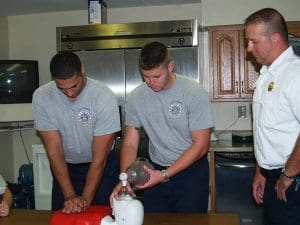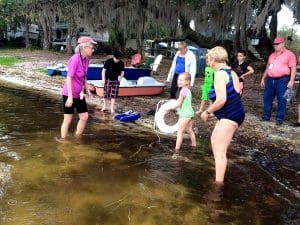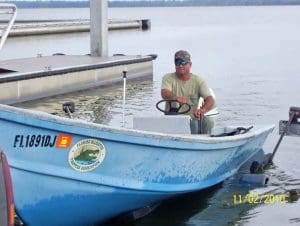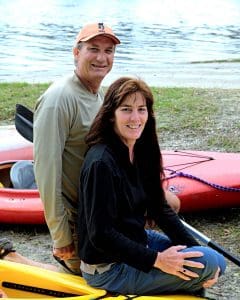Get wet, but not too wild
It’s swimming and boating season in Florida! But before you make that first splash, please consider these important water safety tips that we’ve “pooled” together.
The warm weather that comes with April finally arrived. For many Lake County residents, that means dusting off their swimming trunks and bathing suits and enjoying the area’s abundance of water-related recreational activities.
Some prefer the convenience of their home pool, where they can float lazily on a raft or enjoy an exciting game of Marco Polo with family members and friends. Others enjoy some fun in the sun at one of the county’s public lakefront beaches, such as Hickory Point in Tavares or Ski Beach in Leesburg. And some enjoy an afternoon of paddling or boating through our scenic waterways.
Water recreation is indeed a way of life here because it’s relaxing and enjoyable. But those who fail to follow simple precautions put themselves at risk for injury or even death.
In the United States, an average of 3,536 drowning fatalities occurred each year from 2005-2014, according to the Centers for Disease Control and Prevention. That’s why Healthy Living is providing readers with valuable water safety tips. Simply put, we want you to stay afloat so you can stay alive.
Swimming pool safety
Taylorrose Long worked two summers as a lifeguard for the recreation departments of Leesburg and Fruitland Park. To be hired, she had to undergo CPR certification training and complete a weeklong water safety course.
Fortunately for her, she never had to save a child or adult from drowning. But she did witness many swimming no-no’s that required constant correction: kids running around the pool, recklessly jumping off the side, and seeing how long they could hold their breath underwater.
“By being a lifeguard, I learned that the things I used to do around the pool as a kid are very dangerous,” says Taylorrose, a sophomore at Lake-Sumter State College who hopes to become a registered nurse. “I think people tend to be lax when it comes to pool safety because they figure as long as they can swim, nothing can go wrong. That’s not true. While people should not walk on eggshells when they’re swimming, they should follow common sense precautions to avoid serious injury.”
 Taylorrose, who lives in Lady Lake, offers the following pool safety tips:
Taylorrose, who lives in Lady Lake, offers the following pool safety tips:
- “Walk slowly in the pool area rather than run. When your feet are wet, you can easily slip or fall and injure yourself.”
- A lot of kids like to play chicken. This is a game where friends sit on each other’s shoulders and try to knock the other pair off balance. This could result in hitting your head on the side of the pool.”
- “Kids also like to wrestle and hold their wrestling partner underwater. This is dangerous because they do not know how long their wrestling partner can hold his breath.”
- “Get out of the pool and rest if you are feeling fatigued. We use every muscle in our body when we swim, so it’s a health hazard to remain in the pool when we’re tired.”
- “Never let a child swim without constant adult supervision. This can help prevent dangerous events from happening.”
- “Don’t attempt to dive into the open part of an inner tube. You might not be able to flip the inner tube back over and get your head in the air.”
- “Don’t attempt to jump into a pool and land on a raft. The raft can fly out from under you and cause you to hit your head on the side of the pool.”
- “Don’t smoke around the swimming pool. Secondhand smoke can seep into the lungs of a child. The child then may start coughing and panicking and get water in his lungs.”
- “Do not drink alcohol and attempt to swim. You run the potential risk of becoming disoriented or passing out.”
- “Avoid attempting backflips off the side of the pool. My brother did that when he was younger and hit his head. He had to go to the hospital.”
- “Do not play near the ladder. If you’re underwater and the ladder snags your bathing suit, you won’t be able to come up for air.”
Keep your life afloat
Lt. Brian Gamble, an emergency technician with Lake County Fire Rescue, explains how to perform CPR on a drowning victim:
 “Make sure the scene is safe. For instance, someone may die in a bathtub due to electrocution.”
“Make sure the scene is safe. For instance, someone may die in a bathtub due to electrocution.”- “Determine the victim’s level of unresponsiveness.”
- “Call 911.”
- “Determine if there are signs of circulation. For example, check for a pulse in the neck.” “
- Begin compression only if there is no pulse. Center your hands two fingers , above the bottom of the rib cage, performing compressions with the heel of your hand.”
- “Perform one compression per second for a total of 30 compressions.”
- “When finished, tilt the victim’s head and lift his chin. See if there are signs of breathing. If the victim spits up water, turn his head to the side so water does not re-enter his lungs.”
- “If there are no signs of breathing, pinch the victim’s nose and place your mouth on the victim’s mouth. Give two breaths by breathing in and exhaling.”
- “If this is ineffective, perform 30 compressions again.”
Lake safety
Ginny Harrison is an American Red Cross-trained swimming instructor of 47 years. She and her husband, Jim, operate Swimming for Life, a Clermont-based ministry that provides swimming scholarships to impoverished and special needs children throughout Lake County, as well as to families who foster and adopt children.
Like most Lake County residents, Ginny is enamored with the county’s picturesque lakes. However, she urges anyone who goes for a swim to do so with caution.
Here are a few of her expert tips:
 “Never swim alone. I always tell people, ‘Even when I’m fully grown, I never swim alone.’”
“Never swim alone. I always tell people, ‘Even when I’m fully grown, I never swim alone.’”- “Anyone who cannot swim or is an average swimmer at best should wear a life jacket.”
- “Know your boundaries. Tell children they can only swim out to a certain point and cannot go beyond that point. Parents must have full supervision of children at all times because, at most lakes, there are no lifeguards.”
- “If you’re with a group of people, have someone blow a whistle on occasion so all swimmers can grab a partner’s hand. That way, a count can be conducted and everyone can be accounted for.”
- “Toddlers should be within arm’s reach of a parent. It only takes a matter of seconds for a toddler to go underwater, and nobody can see the bottom of a lake.”
- “Be wary of amoeba during the hot summer months when the water temperature is hot and the water level is low. They live in warm freshwater and can enter your body through openings in your nose and mouth. They then go to your brain.”
- “If you’re going to swim in a lake, I’d recommend swimming in public beach areas where there are more people, as opposed to swimming in a secluded lake. First, alligators tend to go away when there is lots of human activity in the water. Second, if anything happens, there will be more people to assist you.”
Gator-aid
Speaking of lakes, we all know they are home to Florida’s most popular reptile, the alligator. While an alligator encounter can prove deadly, it’s not a good reason to shun our beautiful lakes. After all, there have been only three alligator-related fatalities in Florida since 2007—and none of them occurred in Lake County.
In other words, your odds of being on the wrong end of an alligator encounter are quite slim.
But, in the event you do come across an alligator, you need to know what to do.
 Johnny Douglas of Wildwood is quite familiar with these reptiles. He spent 31 years as a trapper who removed nuisance alligators from local waterways. He offers some practical advice.
Johnny Douglas of Wildwood is quite familiar with these reptiles. He spent 31 years as a trapper who removed nuisance alligators from local waterways. He offers some practical advice.
If you encounter an alligator on land? “You should run away, but do so in a zigzag pattern. Alligators run in a straight line for 30 feet and then they stop. Once you’ve gotten away, make sure to call the Florida Fish and Wildlife Conservation. Although it is a rare occurrence, if an alligator chases you on land, it has lost all fear of humans.”
If you encounter an alligator in water? “Be as still as possible at first and then slowly ease your way back to shore. If you move too quickly and start splashing, the alligator may recognize you as prey and begin chasing you. Plus, you cannot out-swim an alligator. If the alligator attacks you, then the best defense is to poke its eye sockets with your fingers. Oftentimes, alligators will release their grip once you do this.”
A valuable tip: “Don’t ever walk your dog next to the lake. Dogs are like prime rib to alligators. Throughout the years, I’ve trapped hundreds and hundreds of alligators that attacked and killed dogs.”
Kayaking safety
Kayaking offers one of the most relaxing and peaceful ways to explore our county’s vast waterways. Just ask Kenny and Jenny Body. The couple own Central Florida Nature Adventures in Eustis and take paddlers on trips through the Dora Canal, Haynes Creek, the Wekiva River, and other bodies of water.
“We take people out from all over the state,” Kenny says. “Because we live in a subtropical environment, we see all kinds of wildlife in their natural habitat. It’s also a very healthy activity because paddlers build muscles in their arms, legs, and core.”
 Kenny offers some basic kayaking safety tips:
Kenny offers some basic kayaking safety tips:
- “Don’t paddle at night by yourself. Alligators typically feed at night, and they’re also very difficult to see at night. I recommend everyone be off the water by dark.”
- “Avoid getting too close to overhanging branches. They are often places where wasps and other stinging insects live.”
- Beware of poison ivy. Paddlers exiting their kayak have a tendency to lean on a tree where poison ivy is growing.”
- “Always have bug spray. Otherwise, you’re a sitting duck if mosquitoes and deerflies are out.”
- “Keep your weight in the boat. If you start looking behind you while trying to take pictures, you lose center gravity and start tipping the kayak. I’ve seen people fall out of a kayak because they were taking pictures.”
- “Don’t bring Styrofoam coolers because you’ll lose everything if you tip. Instead, bring flip-top coolers and dry bags.”
- “When you are paddling, extend your elbow and put the paddle in the water out by your feet and bring it back to your hip. This is the best way to get maximum thrust and exercise.”
- “Never paddle further than your capability.”
Boating safety
Clermont resident Joe Goloversic has served five years as a member of Lake County Flotilla 43 Coast Guard Auxiliary. He particularly enjoys teaching eight-hour boating safety classes.
“You’d be amazed how many people take the class who have been boating for 15 years,” he says. “They leave the class amazed at how many things they did not know about boating. Boating can be a very dangerous hobby if not managed and looked after.”
With 1,400 named lakes, Lake County offers ample boating opportunities.
 However, Joe highly recommends following precautions to avoid accidents and tragedies.
However, Joe highly recommends following precautions to avoid accidents and tragedies.
- “The most important thing is to prepare your vessel. Make sure the engine is well tuned, the fuel tank is clean with no moisture, and the battery is free of corrosion. When the boat is not in use, the battery should always be kept inside a case.”
- “Prepare a checklist to ensure you have all the necessary supplies. Those should include life jackets, first-aid kit, sunscreen, ice water, and food.”
- “Have a life jacket for everyone on the boat.”
- “Bring a boat hook in case someone falls out of the boat. Hand them the boat hook so you can pull them toward the boat. Never jump into the lake and try to save somebody. That’s the last thing you want because you now have two people overboard. And don’t think just because you’re a good swimmer that saving somebody is going to be easy. The environment of a lake is much different than a swimming pool. You have to deal with muck, wind, and plants.”
- Make sure navigation lights are working if you’re going to be out on the water at night. You have to have a single white light at the highest point in the vessel.”
- “Every boat should have a VHF radio. You can purchase them for under $100. There is not one blind spot in Florida where people cannot be heard on a radio. With a radio, an ambulance can be waiting for you at the dock if something bad happens. And if you or one of the passengers is having a heart attack, having that radio can potentially be lifesaving.”
- “Always bring an air horn in case another boater is not paying attention to the rules of boating navigation.”
- “Always have a fire extinguisher on your boat and inspect it yearly.”
Water Safety Day
The Lake County Water Safety Advisory Committee will host Water Safety Day May 20. This year’s theme is “Do Your Part to Be Water Smart.”
The event is at multiple locations throughout Lake County, including Waterfront Park in Clermont, the Golden Triangle YMCA in Tavares, and the city recreational pools in Fruitland Park, Leesburg, Umatilla, and Mount Dora.
Members of various local agencies provide swim lessons, demonstrate CPR on mannequins, and perform a mock drowning rescue. Those agencies include the Lake County Flotilla 43 Coast Guard Auxiliary and the American Red Cross.
“We want everyone to enjoy the abundance of water in our county, but at the same time, we want everyone to be safe,” says Stephanie Glass, who serves as staff liaison of the event. “This is a great opportunity for families to learn about water safety so they can have fun on the water instead of dealing with an emergency.”
For more information, contact Stephanie at 352.742.6511.

